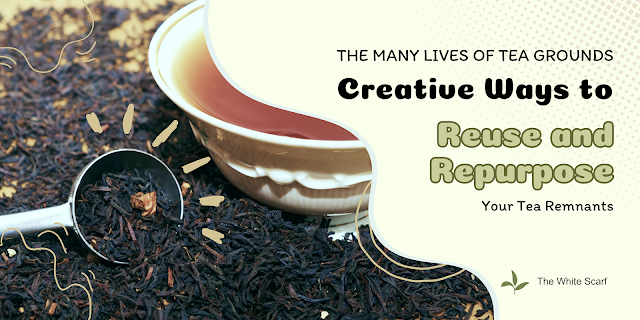The Many Lives of Tea Grounds: Creative Ways to Reuse and Repurpose Your Tea Remnants
Introduction: A Cup of Tea and a Pile of Grounds
As the days grow colder or busier, many of us find comfort in a warm cup of tea. Whether it’s a fragrant jasmine, a bold black tea, or a soothing chamomile, tea has a way of grounding us in the moment. But what happens when we finish our cup? Often, we’re left with a pile of tea grounds—damp leaves sitting at the bottom of our cups or teapots, seemingly useless. If you’re an avid tea drinker, you might be wondering: Is there a better way to use these tea grounds instead of simply tossing them away?
The good news is that tea grounds have plenty of practical, creative, and even mystical uses. In this post, we’ll explore different ways to give them a second life, from enriching soil to enhancing beauty routines, and even predicting the future.
1. Gardening & Sustainability: Nourishing the Earth
Tea grounds are packed with nutrients that plants love. Instead of throwing them away, try these eco-friendly gardening tricks:
- Natural Fertilizer – Tea leaves contain nitrogen, potassium, and phosphorus, making them a great natural fertilizer. Simply sprinkle them around your plants or mix them into the soil.
- Compost Booster – Add used tea grounds to your compost bin to speed up decomposition and enrich the compost with essential nutrients.
- Pest Repellent – Some pests, such as aphids and mosquitoes, dislike the smell of tea. Spread tea leaves around plants to help deter unwanted visitors.
- Acid-Loving Plants’ Best Friend – Tea grounds slightly lower soil pH, making them ideal for plants like roses, azaleas, and blueberries.
2. Household Hacks: Cleaning and Freshening Up Your Space
Tea grounds have natural absorbing and cleaning properties. Here’s how they can work wonders in your home:
- Odor Absorber – Dry out used tea leaves and place them in a small bowl in your fridge, shoes, or trash bin to neutralize odors.
- Carpet & Rug Freshener – Sprinkle dried tea leaves onto carpets, let them sit for 15 minutes, then vacuum them up for a fresh scent.
- Glass & Mirror Cleaner – Use damp tea leaves to wipe mirrors and windows to remove fingerprints and streaks naturally.
- De-Greaser – Scrub greasy pans, dishes, or countertops with tea grounds for an eco-friendly cleaning solution.
3. Skincare & Self-Care: A Natural Beauty Boost
Used tea leaves are rich in antioxidants and can be repurposed for personal care:
- Face & Body Scrub – Mix tea leaves with honey or yogurt for a gentle exfoliating scrub that removes dead skin cells and nourishes your skin.
- Soothing Eye Compress – Place damp tea bags over your eyes for a few minutes to reduce puffiness and dark circles.
- Hair Rinse for Shine – Brew weak tea from used grounds and use it as a final rinse to add shine and softness to your hair.
- Relaxing Foot Soak – Add tea grounds to warm water and soak your feet for a refreshing, odor-neutralizing treatment.
4. Cooking & Creative Culinary Uses
Tea grounds aren’t just for brewing—they can add unique flavors to food and drinks:
- Tea-Smoked Dishes – Use dried tea leaves to smoke meats, tofu, or fish for a rich, aromatic flavor.
- Tea-Infused Rice or Pasta – Brew used tea and cook rice or pasta in the tea water for subtle earthy undertones.
- Tea-Flavored Baked Goods – Add finely ground tea leaves to cookies, cakes, or bread for an extra layer of flavor.
The Mystical Side: Tea Grounds and Their Many Meanings
Beyond practical uses, the term “tea ground” has deeper meanings across cultures:
- Tea Leaf Reading (Tasseography) – The practice of interpreting patterns left by tea grounds in a cup is an ancient form of divination. Some believe these symbols reveal future insights or personal messages.
- Tea Growing Ground (Tea Plantations) – Tea grounds can also refer to the rich soils of famous tea regions such as Darjeeling, Assam, Fujian, and Uji, where some of the world’s best teas are cultivated.
- Finely Ground Tea (Powdered Tea) – Some teas, like matcha, are ground into a fine powder and consumed whole, providing a concentrated boost of antioxidants.
- Soil Enrichment (Tea as Ground Cover) – Used tea leaves can be added to soil to improve its structure and moisture retention, making it a sustainable way to recycle organic waste.
- Tea Culture & Community (A Gathering Place) – In some traditions, “tea ground” symbolizes a space where people come together to share stories, wisdom, and a warm cup of tea.
Strategic Insights: The Business of Tea Grounds
Beyond practical applications, tea remnants carry potential in business and cultural contexts:
- Sustainable Product Development – Companies can integrate used tea grounds into compostable packaging, natural skincare, or textile dyeing.
- Consumer Engagement & Brand Loyalty – Businesses that promote tea ground repurposing can enhance brand reputation and customer loyalty through eco-conscious initiatives.
- Waste Reduction in Tea Industry – Restaurants and tea manufacturers can establish partnerships with composting programs or local farms, reducing landfill contributions.
Final Thoughts: Let’s Give Tea Grounds a Second Life
The next time you finish a cup of tea, think twice before tossing the grounds away. Whether you use them in your garden, freshen up your home, create beauty treatments, or explore their mystical meanings, tea grounds have far more potential than we often realize. By repurposing them, we not only reduce waste but also embrace a more sustainable, mindful way of living—one tea cup at a time.
Do you have a favorite way to reuse tea grounds? Share your ideas in the comments below! 🍵✨

